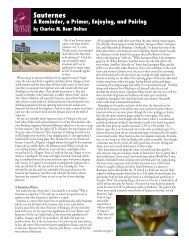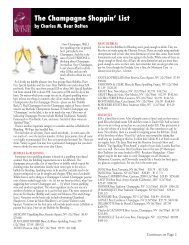What I Tasted on My Spring Break - SPEC's Liquors
What I Tasted on My Spring Break - SPEC's Liquors
What I Tasted on My Spring Break - SPEC's Liquors
Create successful ePaper yourself
Turn your PDF publications into a flip-book with our unique Google optimized e-Paper software.
1998 offered a great vintage for the right bank appellati<strong>on</strong>s of St. Emili<strong>on</strong> and Pomerol (as well as<br />
M<strong>on</strong>tagne and Lussac St. Emili<strong>on</strong> Lalande de Pomerol, Fr<strong>on</strong>sac, Cotes de Castill<strong>on</strong>, and Cotes de Francs)<br />
and the left bank Graves red and white wine area (especially wines labeled Pessac-Leognan). These areas<br />
benefited from a combinati<strong>on</strong> of warm weather and early ripening varieties (a lot of Merlot and Cabernet<br />
Franc). 1998 was a fine but not great year for the later ripening left bank Cabernet Sauvign<strong>on</strong>-based<br />
wines. Except for the top Pomerol and St. Emili<strong>on</strong> Chateaux (especially the over-hyped "garagistas"), the<br />
wines were well priced as futures and offered many fine buys. The classically structured 1998s are now<br />
mostly in the dumb stage but the Merlot-based wines are not deep into it and still are showing well. The<br />
best Cabernet-based wines still need time to emerge. These underrated, well-balanced, classically-styled<br />
Margaux, Pauillac, and St. Julien wines will offer excellent drinking beginning in the next couple of years.<br />
1999 is a vintage that was initially underrated by virtually all of the wine press and much of the wine<br />
trade. Almost all of them have revised their opini<strong>on</strong>s upward. 1999 is a very even vintage featuring<br />
elegant, very well balanced wines with lovely fresh fruit flavors. They are a pure pleasure to drink now but<br />
they also are developing nicely and will c<strong>on</strong>tinue to improve. This is a fine vintage to hold or drink while<br />
you are waiting <strong>on</strong> your 1996s, 1998s and 2000s.<br />
2000 is an excellent vintage with very c<strong>on</strong>sistent, very high quality all over Bordeaux. The weather was<br />
excellent and everything got ripe. All the improving vineyard practice and winery wizardry via the<br />
c<strong>on</strong>sulting enologists paid off. Then the hype machine kicked in. It was the vintage of the turn of the<br />
millennium. And Parker loved it. And the Spectator loved it. And the prices, especially <strong>on</strong> the top wines,<br />
shot through the roof as greed and speculati<strong>on</strong> took over. It is a great vintage to hold for 5 to 25 years<br />
depending <strong>on</strong> the chateau. The most hyped wines are way over-priced but that is no different from any<br />
other great vintage. The 2000s are now mostly in stock and most futures purchases have been delivered<br />
(most but not all – we are still waiting <strong>on</strong> a few wines).<br />
2001 is a very even, very good vintage with fine wines made in all areas of Bordeaux. It was a vintage<br />
where properties capable of making balanced, elegant, multi-dimensi<strong>on</strong>al wines excelled and wineries<br />
depending <strong>on</strong> <strong>on</strong>ly ripeness and manipulati<strong>on</strong> did alright but no better than alright. 2001 required some<br />
quality in terroir for the best wines. The wines that are now coming into the market are well balanced with<br />
good fruit and some of 1999s evenness and elegance. They are drinking well now <strong>on</strong> release and should<br />
c<strong>on</strong>tinue to drink very well as young wines over the next year or so. They mostly likely then will go dumb<br />
and require some patience before they blossom at the end of the dumb stage. As they are balanced and not<br />
too extracted, they should not go too dumb and most will remain drinkable as they develop. 2001 was<br />
reas<strong>on</strong>ably priced and bought with str<strong>on</strong>g dollars so, like the 1999s these wines represent fine values. In<br />
additi<strong>on</strong> to its many fine and excellent dry red and white wines, 2001 was an excellent Sauternes vintage<br />
2002 is a vintage where the terroir sh<strong>on</strong>e like few others. If you taste and c<strong>on</strong>sider <strong>on</strong>ly the top 80 to 100<br />
wines (mostly - but not exclusively - from the left bank) that are the product of great terroir, 2002 is an<br />
excellent to outstanding vintage. If you c<strong>on</strong>sider <strong>on</strong>ly the other several hundred chateaux that do not<br />
possess great terroir or were not in the right weather patterns, 2002 could be a mediocre to poor vintage.<br />
It really is a vintage of haves and have-nots where it was very important to taste before buying. Spec’s<br />
offered fewer 2002s as futures than any vintage since 1994 but those 2002s that we bought and offered we<br />
can endorse unequivically. The 2002s, still available as futures, were bought with str<strong>on</strong>g dollars and the<br />
hype machine never really kicked in so they are excellent values, especially when compared to the 2003s<br />
now being offered as futures.<br />
The 2003 vintage was <strong>on</strong>e of the hottest <strong>on</strong> record. It was so hot that some areas where the<br />
early ripening Merlot is the dominant grape variety suffered severe heat stress and could<br />
not make good wines. Ch. Le Pin was unable to even produce a crop and Vieux Ch.<br />
Certan produced <strong>on</strong>ly 800 cases instead of its usual 4000 (although that 800 cases<br />
is excellent). However, those properties with the right terroir and the right<br />
grapes planted made excellent wines that were very easy to taste and<br />
evaluate. The top Cabernet Sauvign<strong>on</strong>-based wines show a stylistic<br />
similarity to 1990 and 1982. For these (mostly left bank) wines, 2003 is<br />
an excellent to outstanding vintage where even wines from the<br />
northern, cooler areas of the Medoc had fine to excellent potential.<br />
The bad news is that the Bordeaux wine press hype machine has<br />
kicked in and some wineries took ridiculous price increases. The<br />
worse news is that the dollar is as weak as it has ever been against<br />
the Euro which has caused prices in dollars to rise even further.<br />
These wines are not cheap but like 1990 and 1982, they will<br />
provide c<strong>on</strong>sistently pleasurable drinking for many years to come.<br />
View from<br />
St. Julien;<br />
Ch. Pich<strong>on</strong> Bar<strong>on</strong> <strong>on</strong> left and<br />
Pich<strong>on</strong> Lalande <strong>on</strong> right<br />
713-526-8787<br />
Dumb Stage (c<strong>on</strong>tinued from p. 2)<br />
youth and gains the complexity of a<br />
bottle-developed bouquet. Most wines do<br />
not go discernibly dumb but the dumb<br />
stage is a factor with most red Bordeaux<br />
wines. However good they may taste <strong>on</strong><br />
release (and many are incredibly good <strong>on</strong><br />
release), fine red Bordeaux is intended to<br />
develop with age.<br />
In most vintages, the wine closes down<br />
for a period as it changes in the bottle. In<br />
some vintages, the wine goes more dumb<br />
and stays dumb l<strong>on</strong>ger. In other<br />
vintages, the wines are much less<br />
affected and/or are affected for a shorter<br />
period of time. Really hot Bordeaux<br />
vintages (1982, 1990, 2003) tend to<br />
produce wines with lower acidity. The<br />
lower acid wines d<strong>on</strong>’t go as dumb and<br />
may stay in the dumb stage for a<br />
relatively shorter period. Great classic<br />
Bordeaux vintages (1986, 1989, 1996)<br />
tend to have more acidity and so, go<br />
more deeply into the dumb stage.<br />
Medium-weight, well-balanced vintages<br />
like 1999 go dumb but d<strong>on</strong>’t go deeply<br />
into it and the wines d<strong>on</strong>’t stay dumb as<br />
l<strong>on</strong>g.<br />
Generally speaking, the most expensive<br />
wines - the biggest, most intense, most<br />
extracted wines - go dumb for the<br />
l<strong>on</strong>gest time and the least expensive<br />
Bordeaux reds may not go dumb at all<br />
(because the least expensive wines often<br />
have all the development they will ever<br />
need by the time they are released).<br />
Almost all the 1990s have emerged but<br />
many of the best 1989s could use a<br />
couple of more years to fully emerge.<br />
Even some 1986s are still finishing up.<br />
On the other hand, many 1995s have<br />
already emerged.<br />
<str<strong>on</strong>g>What</str<strong>on</strong>g> happens if you drink a wine<br />
during the dumb stage A lot depends <strong>on</strong><br />
where the wine is in its development but<br />
most of them actually taste pretty good –<br />
just not as good as they did or will. You<br />
can help them taste better by splashing<br />
the wine into a decanter (as opposed to<br />
gently decanting it). I like to use a cheap<br />
<strong>on</strong>e-liter glass carafe for this so I can<br />
turn the bottle upside down with its<br />
neck in the carafe and let the wine glug<br />
out. Unless you are holding a treasure for<br />
optimum aging, d<strong>on</strong>’t be too c<strong>on</strong>cerned<br />
about the dumb stage. It is a factor but<br />
you must also remember that you can’t<br />
enjoy your wines unless you drink them.<br />
If you are going to drink a wine too late<br />
or too so<strong>on</strong>, it is always better to err <strong>on</strong><br />
the side of too so<strong>on</strong>. The most important<br />
thing is to drink your wine.





